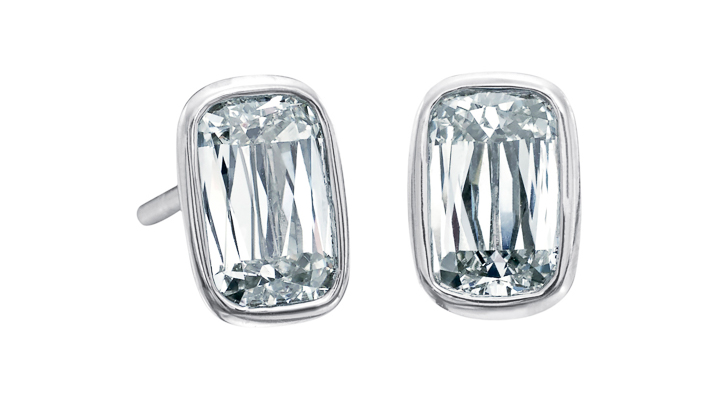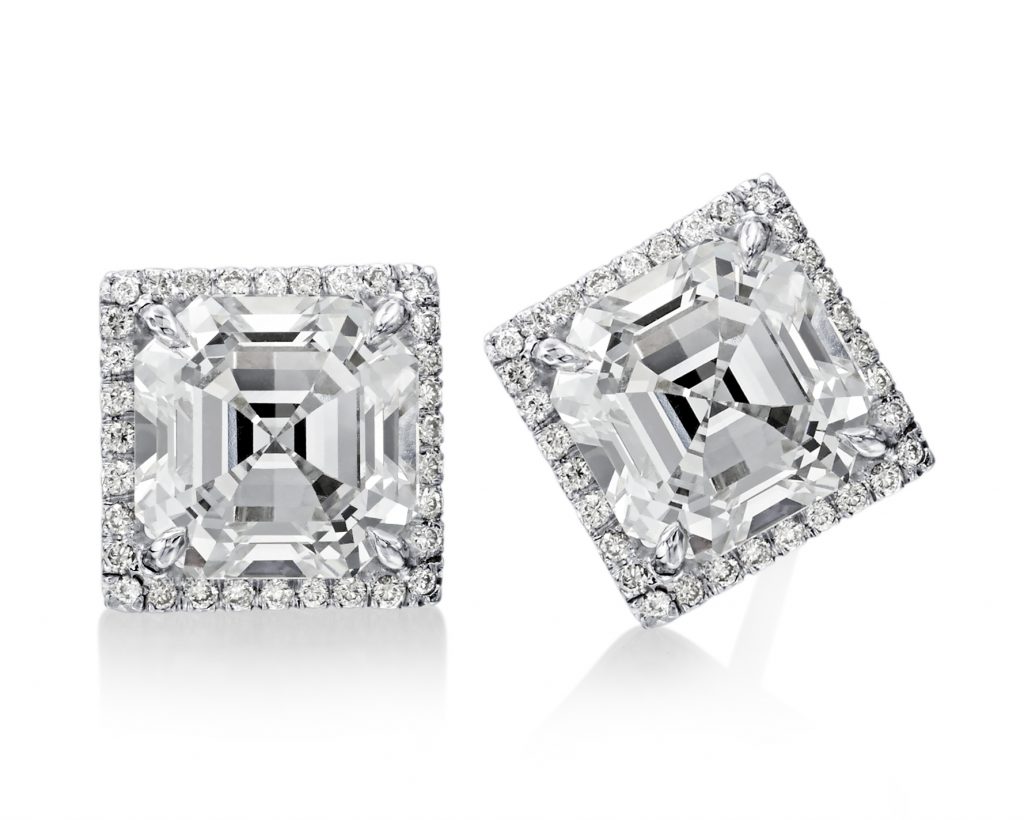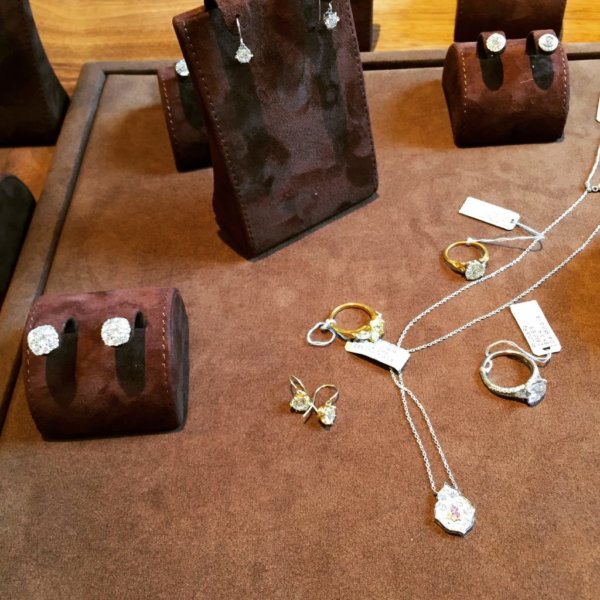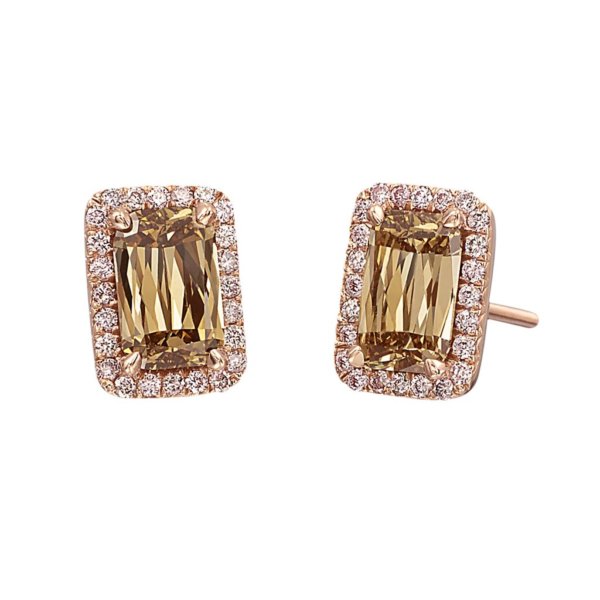Why Diamond Stud Earrings are the Little Black Dress of Jewelry
One woman describes the process of purchasing her perfect pair of natural diamond stud earrings.

A good fifteen years ago, I was invited to a black-tie event as a guest of Ralph Lauren fragrances. As is often the case, they loaned me a Lauren gown and earrings to help me dress the part. The gown, I had to return, but I got to keep the earrings—large cubic zirconia stud earrings that, had they been real, would have easily hit the 2 carat mark.
They’ve become my go-to pair ever since. I wear them just about every day, but most certainly on days when they serve as good luck charms. They are with me during my annual mammogram, they were there when I closed on my apartment in 2002, and they joined me on my first date with my husband. They’re also my sporty spice; their simplicity and close proximity to my ears make them the one accessory I can cycle, ski and swim with.
Over the years, they’ve grown a bit long in the tooth, having lost their faux lustre somewhere in the Aughts. Yet, every time I consider that it might be time to retire them, someone assesses with a raised eyebrow and nod, letting me know that they are impressed with my—or someone’s—potent generosity. Whether I come clean about my earrings’ true provenance depends on who the complimentor is. Call me superficial, but I relish fooling the designer-obsessed snobs who find themselves reassessing me as I walk away from them. But, heck, I’m no better than they: being perceived as a woman who owns a pair of impressive diamond stud earrings makes me feel cooler. Moreover, it always ignites the yearning to own a bona fide pair.

Growing up, diamond stud earrings were what the rich girls wore. In college, my wealthy friend Kim borrowed her mom’s for formals. When I started at Glamour magazine, the same editorial assistants who wore Chanel flats and carried Hermes Birkin bags also had diamond studs in their pierced ears. And, like those flats and that bag, the earrings were timeless.
Having gotten married eleven years ago, along with the incredulity that came from finding the perfect mate, I could not wrap my head around the fact that I had become the proud owner of a spectacular diamond engagement ring and the perfect wedding band. To this day, I marvel at their beauty every time I observe them on my hands. As I near a fairly monumental birthday, I’ve begun to start thinking about gifting myself a pair of diamond stud earrings. But, being pretty much a neophyte about stones, I decided to go straight to the experts. First stop: William Goldberg, in New York’s storied Diamond district.


“I think of studs as a little black dress. Everyone should have them in their wardrobe and you can’t go wrong with them,” says Eve Goldberg, vice president and creative director at William Goldberg Diamond Corporation, which, coincidentally, is the same jewelry house that designed my diamond engagement ring (a pale yellow, cushion cut diamond hugged by two half moons)
Eve is wearing a pair of Golden Goose sneakers covered in glitter, which seem fitting for our discussion. She presents a tray of diamond earrings in different shaped designs. I begin examining them and asking my questions, beginning with comfort and fit.
“You want them to be set as low as possible and as flat as possible to the ear, so they lay close,” she explains. “But the most important thing is that the diamonds are a beautiful cut.”
I ask whether my beloved cushion cuts would work as diamond stud earrings.
“You don’t get as much brilliance with a cushion cut diamond,” explains Eve. “On the other hand, that’s also the reason why some people love them. They are understated, but more and more, people want the brilliance.”
More importantly, though, she warns: “Diamonds shrink.”
Excuse me?
“They shrink!” she laughs lightly, with a shrug. “Think about it: If you’re going from wearing practically nothing on your ears to wearing 2 carat studs, of course it feels over the top at first. But you eventually get used to it and then they might seem too small. I always say, go a little bigger.”
Which brings us to the pair of 3 carat Ashoka studs sitting before me, begging to be caressed. The Ashoka cut diamond is a Goldberg original. It’s essentially a modified cushion-cut, with a rectangular shape and rounded corners. Its 62 facets can help a stone appear larger than it is, but, given the length that’s required for an Ashoka, they are rare.
She informs me of the price tag and I nod slowly, so as not to disturb them, or risk dropping one then helplessly watching it fall through an imagined crack… But, to get serious again, they are divine, with a vintage style to them which attracts many an Ashoka fan.
“What’s on your ear?” I ask. Eve is wearing what appears to be three Ashoka cut diamonds floating up her ear.
“Oh, these are fun,” she says as she reaches up and easily removes the stones in one gesture, revealing that they are attached to each other by a wire, held on her ear by a discreet clip.
“I call these ear climbers,” she explains. “Aren’t they fun? I often forget that I’m wearing them because they’re so comfortable. If you’re on a budget, they’re fantastic.”
Her saying “budget” makes me wonder if it’s obvious that I’m on a budget (and I’m not even wearing my fake CZs…)
Perhaps to overcompensate my budgetary shortcomings, I point to the largest pair on the tray.
“Oh,” smiles Eve, smiling as she picks up a pair of 3.5 carat brilliant round cut diamonds. This is big girl jewelry.”
My shaking hands give my excitement away as I clumsily work on forcing them through my earlobes. Not exactly big girl behavior.
“One of the first major jewelry pieces I bought myself were vintage diamond earrings,” recalls Stellene Volandes, editor-in-chief of Town & Country magazine. “That was about twenty years ago. When I first bought them I took them out for really special occasions. Just last week, I wore them three times. Sometimes I wear them to the office. It felt like a monumental decision back then. Now, it feels like a very wise one.”
Stellene grew up being educated on fine jewelry, tagging along with her father when buying her mother gifts, “which were always jewelry related,” she explains.
Over the course of her career, which also included positions at Vogue and Departures, Stellene credits the numerous “great jewelry teachers” she’s had, including the Lalaounis family, Audrey Friedman from Primavera Gallery, Lee Siegelson and Rebecca Selva at Fred Leighton.
“They are all in love with jewelry, but it’s also an intellectual pursuit,” she says. “They’ve taught me to ask questions of jewelry that one wouldn’t think to ask of a bright and shiny object—when was it made, why were these materials available, where were people suddenly traveling to around this time, what was in the news. That approach is what led to this deep love I have for the art.”
Goldberg appreciates women like Stellene, who buy for themselves because of that deep love of jewelry.
“A lot of time the husband is involved, which I think is a pity. I have one female friend who’s very successful. She came in the other day and bought earrings, rings and a necklace for herself. That’s my favorite customer. Women still like the idea of a man buying them the jewelry. It’s in our culture that it should be a gift. But that’s bullshit. There’s nothing else we wear that has that kind of purchasing opinion besides jewelry. Why is that?”
Vollandes concurs the annoyance, as well as the sentiment.
“We rarely ask for permission to buy shoes or a bag or a dress, but we do ask about jewelry, and they’re often around the same price,” she opines. “When a woman asks me if she should buy something for herself, my answer is always. ‘Yes, you deserve it.’ Or, sometimes, ‘Just go for it!’”
I leave William Goldberg with a few thoughts. Those 2-carat diamond studs were lovely, but, as Eve pointed out, they will shrink. Objects will appear smaller than they were when you first purchased them.
This brings to mind my mother’s diamond engagement ring, with its one teeny diamond I had been so in awe of as a child. Maybe Eve could include it as an ear climber. But then I’d have to buy the other two or three. Maybe I need to explore more. Jamie Rosen has her dream pair in mind.
“I’d like a pair of old mine cuts on a French wire,” she says. Also at Town & Country, Jame is the magazine’s beauty director, but she earned her diamond stripes back at W when she worked at their offshoot magazine, W Jewelry, before I nabbed her to join me at W’s beauty department.
“Nina Runsdorf has a gorgeous pair. So does Munnu Gem Palace. As does taffin,” smiles Jamie. “I do my research.”
Like Stellene, diamond jewelry and stones are a passion for Jamie. During her time at W Jewelry, she had met gemologist Walter McTeigue, of McTeigue and McClelland jewelers. Their pieces combine classic European cut diamond designs with modern twists, and Jamie’s engagement ring that they designed—a cushion cut diamond surrounded by yellow gold petals—is such a work of beauty, it inspired me to introduce myself to the jewelers a few years ago. Their headquarters are in Great Barrington, Mass., not far from our weekend house.
“Diamond studs are a staple,” agrees Walter McTeigue. “They are timeless, but not particularly interesting, so they really rely on the beauty of the diamond, and the size. Because of that, they can be expensive if you want a big look.”
He pulls a pair of diamond stud earrings the size of peanut M&Ms, and I nearly fall to the floor—but not before stretching my arm out to secure them in my hand.
“These are big studs,” says Walter, stating the obvious, then peering at the little price tag attached to them, pronounces the price, which is a zero or two outside my price range.
Walter grew up, quite literally, in the Diamond District. He is a fourth generation jeweler, who, after working for his dad, left the family business to join Harry Winston as estate jewelry buyer—which would explain his penchant for old-school European cut diamonds. He explains to me how the classic European cut went out of fashion in the early 1900’s thanks to a scientist named Marcel Tolkowsky, who created a formula for achieving a diamond’s maximum brilliance.
“He set the standard, and his formulas are still being used today,” says Walter. “But my partner Tim and I just feel that those old cuts were more charming. They may have had less brilliance, but they had a lot of character and uniqueness. We thought, ‘That’s what we want to use.’ Our whole angle is to have something other jewelers don’t have.”
“Like the Ashoka?” I ask.
“Exactly,” confirms Walter. “That was a brilliant move on their part.”
Pardon the pun…
When I ask Walter what of the 4 Cs of diamonds is the most important when it comes to earrings, he shrugs.
“We’re kind of loose. Cut is important. And for clarity, it needs to be clean to the naked eye, of course, which is kind of subjective. Some can see tiny flaws, but if they’re slightly imperfect, it reduces the price quite a bit.”
He shows me a pair of imperfect studs somewhere between one and 2 carats that are 0 in color.
“Some woman who’s always wanted a nice pair but can only spend a certain amount is going to love these and no one’s gonna see any imperfection. They’re gonna do their job, which is to sparkle.”
And then he lifts a pair of modest diamonds (1.76 carats) held by a delicate wire. I am intrigued.
“The dangles are nice, more interesting,” he says, and I immediately think back to Jamie’s wish list containing a similar design. “Their movement gives it more energy.”
Walter sees how my interest is piqued, and, since he is my friend, he asks, “Would you like to wear them out tonight?”
I can hardly contain my excitement. Despite the fairly modest carat size, wearing them makes me feel as though a sign is hanging from my neck that reads, “YES. THEY ARE DIAMONDS AND YES THEY ARE REAL.”
I wear the earrings to a party that evening and, along with receiving a few compliments, I feel special. On the drive back to McTeigue and McLelland the following morning, I create about half dozen scenarios that might allow my budget to swing the price of the dangles, but it proves tricky. I love the studs, but the dangles might be more me. No one is more surprised than myself about this shift in interest. Have I grown more interesting in my seasoned age?
I think about what Stellene says about trusting her gut, and then Jamie’s touching comment about the intimacy of the purchase.
“There is an empowerment associated with buying your jewelry, and not waiting for anyone to do it for you,” says Jamie. “It’s not a purchase that requires a third party. It’s between you and the stone.”
Got it. Me and the diamond stone. And my wallet. I walk into the jewelry store and sit down with Walter.
“I have a proposition, diamond-wise,” I smile as I hand over the velvet pouch that holds the precious dangles. “I know you like estate diamonds. What about mini estate diamonds?”
Before I grant him the opportunity to graciously bow out, I tell him about my mother’s engagement ring and ask if he’d consider trying to match it with another small estate diamond to create a pair of my very own dangle earrings.
“Of course!” he smiles.
I hand the borrowed dangles back and call my brother, the perpetual bachelor but to whom Mom’s ring was bequeathed. He says I can have it. Hopefully, my sister will agree to the idea as well. Maybe an offer to share them will sweeten the prospect. I really want this to happen, and I feel emboldened by the plan.
“Jewelry is power,” Stellene reminds me. “Before Catherine the Great met with her generals she always loaded on her emeralds. I feel the same about diamonds.”
